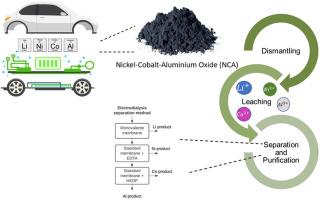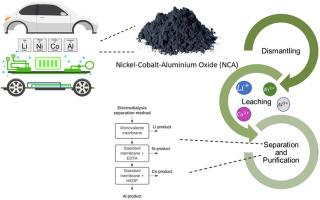电渗析作为一种从nca型汽车锂离子电池中分离金属的途径
IF 10
1区 环境科学与生态学
Q1 ENGINEERING, ENVIRONMENTAL
引用次数: 0
摘要
生产锂离子电池的产业链需要多种金属资源。新电池的生产成本占生产链总成本的50 - 80%。由于分离的效率和产品的纯度,这些不同金属的分离和回收是一个挑战。在金属分离中,电渗析技术具有离子分离效率高,尤其是锂离子分离效率高的优点。我们展示了电渗析作为nca型LIB中存在的金属的分离途径。我们采用了三个分离步骤,首先是Li(纯度98.7%)的分离,然后是Ni(纯度98.5%)的分离,最后是Co(纯度94.7%)和Al(纯度100%)的分离。所开发的工艺路线表明,对一个真实的渗滤液,锂的分离纯化纯度可达92.4%。结果表明,电渗析分离可作为一种替代技术。本文章由计算机程序翻译,如有差异,请以英文原文为准。


Electrodialysis as a route for separating metals from NCA-type automotive lithium-ion batteries
The industrial chain for producing lithium-ion batteries (LIBs) requires various metal resources. The production of new batteries represents 50–80 % of the total cost of the production chain. The separation and recovery of these different metals is a challenge due to the separation's efficiency and the product's purity. In metal separation, the electrodialysis technique has the advantage of high ion separation efficiency, especially Li. We show electrodialysis as a separation route for metals present in NCA-type LIB. We used three separation steps, which first involved the separation of Li (purity 98.7 %), followed by the separation of Ni (purity 98.5 %) and as a final step, the separation of Co (purity 94.7 %) and Al (purity 100 %). The route developed showed that for a real leachate liquor, the separation and purification of Li achieved a purity of 92.4 %. The results indicate that electrodialysis separation can be an alternative technology.
求助全文
通过发布文献求助,成功后即可免费获取论文全文。
去求助
来源期刊

Journal of Cleaner Production
环境科学-工程:环境
CiteScore
20.40
自引率
9.00%
发文量
4720
审稿时长
111 days
期刊介绍:
The Journal of Cleaner Production is an international, transdisciplinary journal that addresses and discusses theoretical and practical Cleaner Production, Environmental, and Sustainability issues. It aims to help societies become more sustainable by focusing on the concept of 'Cleaner Production', which aims at preventing waste production and increasing efficiencies in energy, water, resources, and human capital use. The journal serves as a platform for corporations, governments, education institutions, regions, and societies to engage in discussions and research related to Cleaner Production, environmental, and sustainability practices.
 求助内容:
求助内容: 应助结果提醒方式:
应助结果提醒方式:


